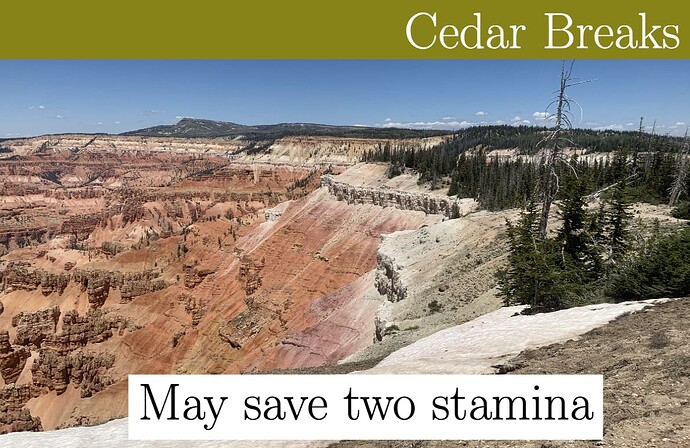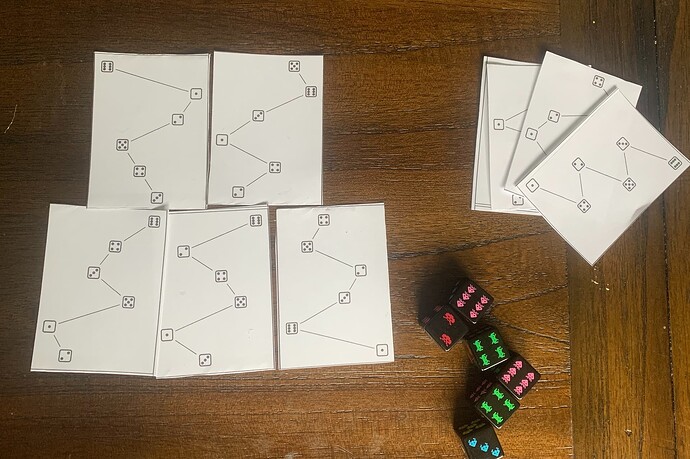I’m entering the second Decision Space podcast game jam and plan to write about it here. If you don’t know, a game jam is contest to create a game under specific constraints. In this case, the game must follow these guidelines:
- 18 Standard size cards - approx. 2.5 inches by 3.5 inches (6.4 cm x 8.9 cm)
- Use both sides of the cards - Can be minor information on the back, or a whole card.
- No hidden hands - Private hidden hand information.
- No other major components - tokens and dice are fine, but boards, tiles, etc. are not.
- Must be playable at 2 or solo.
If you are familiar with Button Shy games, you’ll know what 18-card games are like. They are small enough to fit into a wallet and can be printed using just two sheets of cardstock. My favorite example in this genre is Skulls of Sedlec, which require building pyramids of skulls and scoring points based on how they are arranged.
I’ve been playing Trails, a lovely game created by the people who made Parks. It’s an ideal game to play with my kids since the rules are smooth and it’s just random enough that anyone can win. Thematically it evokes the outdoors: National Park poster art, badges, taking time to snap a photo, canteens, etc. But the act of playing Trails feels less like going on a hike and more like playing an abstract board game.
To get closer to replicating the experience of hiking, I want to create a game where:
- The goal should be to go out in nature and see something wonderful.
- Planning your route should be a critical decision point.
- Deciding when to rest in order to manage your stamina should be the primary gameplay loop.
The first goal gives me the idea of one side of each card: a photo of a location where I’ve hiked. Since each location has a different feel, I can also adjust the rules of the game to evoke the feel of the place. Hiking in the Great Sand Dunes feels like two steps forward and one step back. Walking around a nature trail loop rarely saps my energy. This will give me room to play with the basic mechanics and give players more variety, which is especially useful for solitary games.
This is an idea for a location that makes the game easier. Hiking around the rim of Cedar Breaks isn’t a particularly stressful journey, so this location allows players to save more stamina in reserve. That might make it too easy for this hike, so I’m considering other ideas and moving this to a nature trail situation.
I’ve played around with a few designs, but I need to nail down the core of the system first. For inspiration, I looked at Can’t Stop a dice-based press-your-luck game designed by Sid Sackson in 1980. Some editions theme the game a race between mountaineering expeditions. From reading accounts of people who have attempted to climb Mount Everest, such as “Into Thin Air” about the disaster in 1996, the risk-seeking behavior encouraged by the mechanics (you feel you can’t stop because your goal is right there) reflects the risk-seeking behavior of dedicated climbers.
This gives me my concept for the other side of the cards: paths for players to climb. After playing around with a few designs, I came up paths traced out by 6 dice rolls that must be followed in order to travel. These cards can be reversed to produce 36 paths[1] with 18 cards. Players can place the cards in a sort of ziggurat formation that vaguely resembles maps of multiple climbing routes.
I’m using a set of 18mm Space Invader dice which are slightly too big. I’m going to dig up the 12mm dice I bought a few years ago for the purpose of designing games which should be a better fit for the cards.
I tried a few variations with my 11-year-old twins and settled on this system:
- Roll all six dice.
- Place a die on a spot that matches at the bottom of any of the three lower paths.
- On the first roll after a rest, the player may chose to save one of the remaining dice as stamina for later use.
- Decide if you want to continue or rest.
a. If you continue, roll the dice that have not been placed on the path or saved for stamina.
b. You must play one of the dice you rolled, if it equals the next spot on the path. or your stamina, if it’s equal-to or greater-than the next space on the path. When you reach the top of a bottom card, you may choose either top card to continue your path.
c. If you can’t play either a rolled die or stamina, lose all progress since your last rest and take a forced rest. (Go to step 6.)
d. If you placed a dice, you may decide to continue (repeat step 4) or rest (go to step 5). - If you voluntarily rested, place your trail maker on the last spot you placed a dies on the path.
- Increment your rest counter. Remove all the dice from the path and any unused stamina.
- If you haven’t reached the top spot of the second card, roll again. (Go to step 4.)
- If you have reached the top spot on the second card, you’ve completed the hike. Your score is the number of rest taken with lower being better.
This isn’t the cleanest rules description, but it should give you an idea of how it will work. After writing it, I think it makes sense to let players decide to roll all the dice again without resting after they place all six dice on the cards. This replicates one of the highlights of another of my favorite push-your-luck games, Fill or Bust, which allows players to risk your score by rolling again after you score all six dice.
I initially designed the cards to add up to 21 and allowed duplicates. The rules I was trying at the time allowed all dice to work like stamina dice: equal or greater than the terrain. But that meant a card with a 6 was much harder than one without. Each die has a 1 in 6 chance of passing a 6, but a 2/6 chance to pass a 5. That didn’t seem fun, so I made every card have every number. I’m sticking with that design for now, but it might make the paths more interesting to go back to the version with duplicate numbers.
I’m using \LaTeX to create double-sided cards. It’s really easy to generate new cards now that I have a template. I think I have enough ideas for 18 locations. My plan for the final game is 3 random locations each topping of a 5-card path pyramid to use all 18 cards. It’s loosely based on the Tri-Tip Challenge where people hike three prominent peaks in San Luis Obispo, California. Since each location changes the rules, there will be thousands of possible setups.
Scoring for multiple players is easy enough: first to complete all three locations wins. For solo players, I’m thinking of stealing a page from golf and giving each location a par. An easy location (like the Cedar Breaks card I showed above) would have a something like par 2 or 3. A tough location (such as the Grand Canyon’s rim-to-rim) could be par 10. Winning the game would mean completing the three locations using under the sum of the par[2] assigned the three locations.
There’s a lot left to do before the game is ready for submission, but it feels like I have the basic structure in place. I have a feeling designing a game is like remodelling a house: while it feels great to see the structure in place, it’s the finishing details that take the most time.

